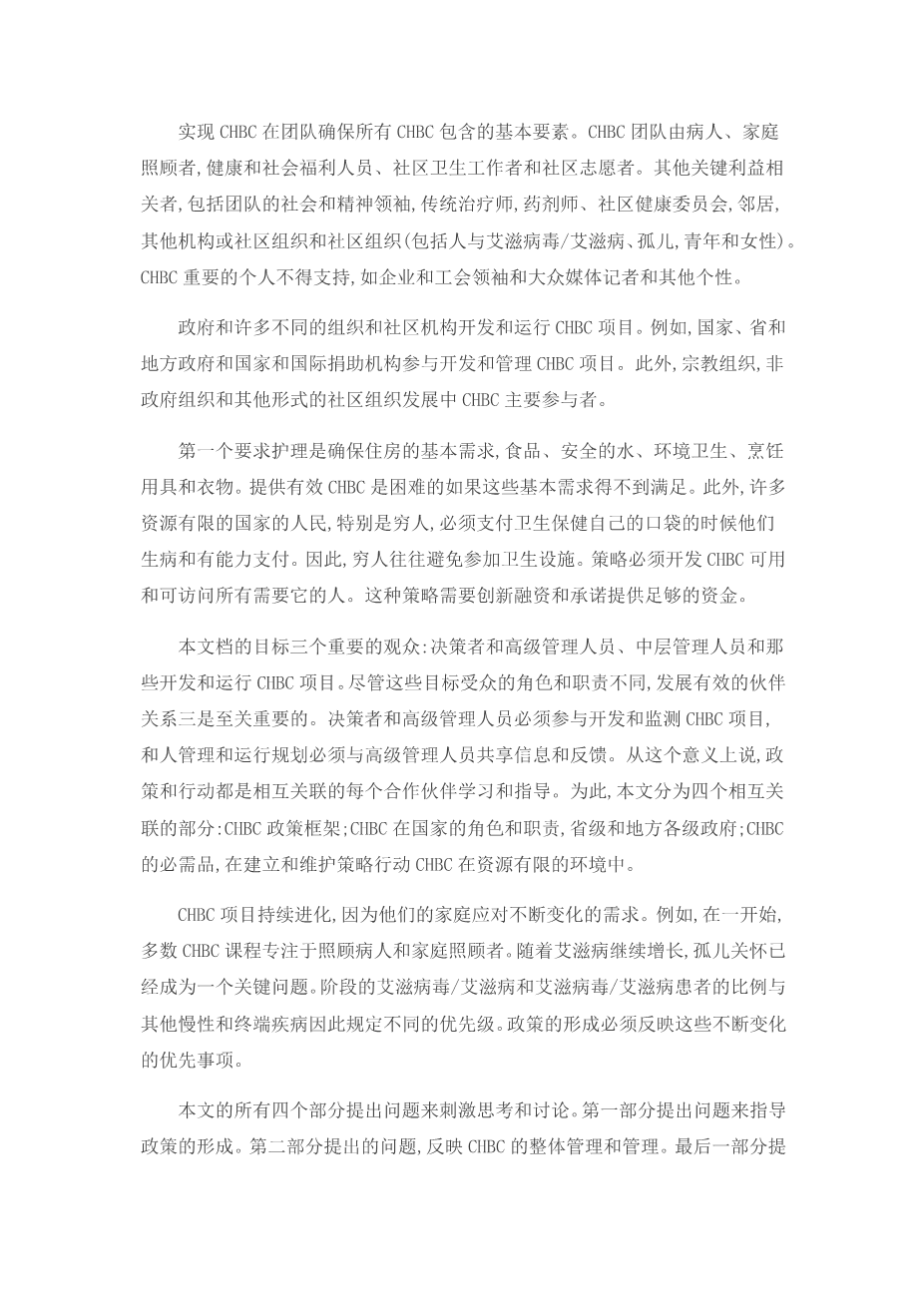COMMUNITY HOME-BASED CARE IN RESOURCE-LIMITED SETTINGS
INTRODUCTION
“Home-based care is taking us back to the root of human coexistence. It reminds us that we all have the responsibility to one another. If we hold hands through this tragedy ... we will be able to retain our humanity and will come out of this epidemic as a stronger community.”
Joy Phumaphi, Minister of Health, Botswana
This document provides a systematic framework for the establishment and maintenance of community home-based care (CHBC) in resource-limited settings. Most CHBC services so far have been established through unsystematic, needs-based efforts. As the HIV/AIDS epidemic continues to grow, many organizations and communities are now considering expanding in a more programmatic approach, and countries are looking for scaled-up responses and national strategies for CHBC. This document therefore provides an important framework to guide governments, national and international donor agencies and community-based organizations (including NGOs), faithbased organizations and community groups) in expanding their CHBC programmes. The need for such a document has been clearly identified.
The overall purpose of this document is to provide a framework for the systematic development and maintenance of CHBC in resource-limited settings for people with HIV/AIDS and other chronic illnesses and disabilities. This document has three interrelated target audiences. First, governments, national and international donor agencies and larger NGOs will find this document useful in making decisions and policy for CHBC programmes. Second, middle (or district) management can follow this framework as they implement policies for developing CHBC. Finally, community groups will find the framework helpful for establishing, monitoring and maintaining CHBC projects.
CHBC is defined as any form of care given to sick people in their homes. Such care includes physical, psychosocial, palliative and spiritual activities. Home care draws on two strengths that exist throughout the world: families and communities. Families are the central focus of care and form the basis of the CHBC team. Communities are places where people live and a source of support and care to individuals and families in need. The goal of CHBC is to provide hope through high-quality and appropriate care that helps family caregivers and sick family members to maintain their independence and achieve the best possible quality of life.
Between 70% and 90% of illness care takes place within the home. Research evidence clearly demonstrates that most people would rather be cared for at home and that effective home care improves the quality of life for ill people and their family caregivers. CHBC is the best way for most people to be cared for and to die. Throughout the world, most caregivers are family members (usually women and young girls), and these caregivers are valued as the main source of care for ill people.
Implementing CHBC in a team ensures that all the essential elements in CHBC are included. The CHBC team consists of ill people, family caregivers, health and social welfare personnel, community health workers and community volunteers. Other key stakeholders that may be included in the team are community and spiritual leaders, traditional healers, pharmacists, community health committees, neighbours, other community agencies or organizations and community groups (including groups of people with HIV/AIDS, orphans, youth and women). A number of significant individuals may support CHBC, such as business and union leaders and journalists and other mass media personalities.
Governments and many different organizations and community agencies develop and run CHBC programmes. For example, national, provincial and local governments and national and international donor agencies have been involved in developing and administering CHBC programmes. In addition, faith-based organizations, NGOs and other forms of community-based organizations have been major players in developing CHBC.
The first requirement for care is to ensure the basic needs of shelter, food, safe water, sanitation, cooking utensils and clothing. Providing effective CHBC is difficult if these basic needs are not being met. In addition, people in many resource-limited countries, and especially poor people, have to pay for health care out of their own pockets at the very time they are sick and least able to pay. As a result, poor people often avoid attending health facilities. Strategies must therefore be developed to make CHBC available and accessible to everyone who needs it. Such strategies will require creativity in financing and a commitment to providing sufficient funds.
This document targets three important audiences: policy-makers and senior administrators, middle managers and those who develop and run CHBC programmes. Although the roles and responsibilities for these target audiences are somewhat different, developing effective partnerships among the three is essential. Policy-makers and senior administrators must be involved in developing and monitoring CHBC programmes, and the people who manage and run the programmes must share information and feedback with senior administrators. In this sense, policy and action are interrelated as each partner learns from and guides the other. To this end, this document is divided into four interrelated sections: a policy framework for CHBC; the roles and responsibilities for CHBC at the national, provincial and local levels of administration; the essentials of CHBC; and the strategies for action in establishing and maintaining CHBC in resource-limited settings.
CHBC programmes are continually evolving as they respond to the changing needs of families. For example, in the beginning, most CHBC programmes focused on the care of ill people and family caregivers. As the AIDS epidemic continuesto grow, orphan care i
剩余内容已隐藏,支付完成后下载完整资料
英语译文共 5 页,剩余内容已隐藏,支付完成后下载完整资料
资料编号:[484487],资料为PDF文档或Word文档,PDF文档可免费转换为Word
以上是毕业论文外文翻译,课题毕业论文、任务书、文献综述、开题报告、程序设计、图纸设计等资料可联系客服协助查找。




